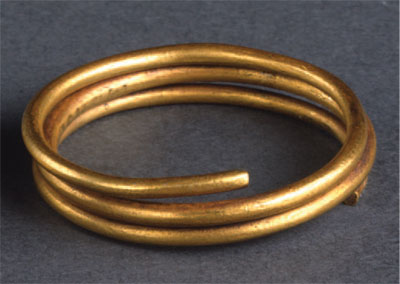
Gold. Through the ages, it has adorned kings and queens and made princes of the common, inspiring greatness and greed alike. From the mask of Tutankhamun to the top medals awarded at the modern Olympic games, gold embodies value and power, both abstract and physical.
Jewelry is a typical use for precious metals. The piece of heavy spiraling gold wire shown here is likely to have been exactly that. But what kind of jewelry was it? Too small to have been a bracelet or a necklace, it was found along with an almost identical piece near the skull of “body number 7” in tomb PG 1237 at Ur. The obvious interpretation is that it was an earring, threaded through a pierced lobe. But also found on the skull were two large gold crescents featuring thin wire loops that were clearly worn in the ears.
Though it is possible to wear more than one earring per ear, the spirals are thick and may have had a different purpose. Such pieces in gold or silver are occasionally found in Bronze Age tombs from Mesopotamia to Greece and are usually interpreted as hair rings. They would have been worn on the ends of braids of hair that hung at or near ear level.
The woman who wore this particular piece of spiraling gold in her braided hair was one of more than seventy people buried in the tomb, apparently retainers of the primary tomb owner. The large number of people arrayed in such a specific fashion led the excavator, Sir Leonard Woolley, to dub the tomb the “Great Death Pit.” Most of the dead were women and many wore hair rings. However, in his notes, Woolley states that the person who wore the one pictured here may have been a harpist. A few musical instruments were found among the dead. Although the bones of body number 7 were not mixed up with the harp, her head was almost touching it.
The main tomb chamber was no longer intact and thus the person who led so many others into the afterlife 4500 years ago was never recovered. But the massive display of decorated retainers and musicians surely designates the importance or royal status of the tomb owner and perhaps the status of the individual retainers as well. Display of wealth plays a large role in the dynamics of power and probably had much to do with establishing and maintaining ancient elites.
The power of gold, however, goes much deeper than its innate allure, curability, and parity. It embodies the very concept of value. There is good evidence that gold and silver performed most of the duties of money in pre-coinage societies, particularly among the elite. There are even ancient texts that mention rings or coils of precious metals used as currency, possibly clipped to provide pieces for payment.
Could it be that this spiral of ancient gold was both jewelry and money? Worn for display, clipped for pay, gold could, and likely did, perform multiple tasks in the ancient world, both representative and material. Even today, we take pleasure in this precious commodity, and it remains as the principal foundation of most modern currencies.
WILLIAM B. HAFFORD is a Research Associate in the University of Pennsylvania Museum’s Near East Section.
